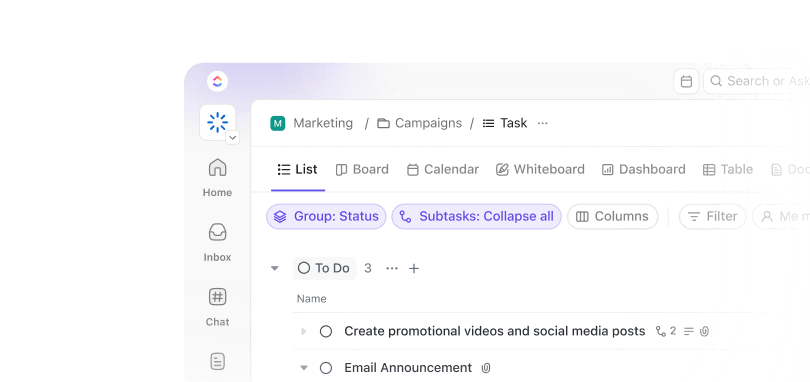When you hear ‘cross-team collaboration’, what comes to mind?
Probably a lot of team meetings, emails, and confusion. But think about The Internship, where two out-of-place interns team up with coders, marketers, and analysts to win a company-wide challenge at Google. They don’t win by being the smartest. They win because they learned to work across different teams and operate as one unified group.
That’s what real collaboration in the workplace looks like. Multiple teams bring different working styles to the table, but momentum disappears without trust and structure.
You can fix that with better team building, clear conversations, and smarter habits. In this article, you’ll learn how to strengthen cross-team collaboration in your own organization and break silos without slowing work down.
Cross-Team Collaboration: How to Break Silos and Work Smarter
What Is Cross-Team Collaboration?
Cross-team collaboration, often called cross-functional team collaboration, involves different departments working together to solve one problem. These teams can include designers, developers, marketers, and sales teams. Each group taps into its own expertise to ensure the project progresses smoothly. Unlike in departmental collaboration, cross-functional teams break down silos that hold progress back.
📌 The iPhone is one of the best-known examples of cross-team collaboration. Apple’s ‘Project Purple’ united hardware, software, and design engineers with the marketing team. They built prototypes, pitched to executives, collected feedback, and improved the offering together.
An engineer even led the launch marketing and starred in the first demo. The team often clashed, miscommunicated, and worked under pressure, but the results speak loudly. Today, the iPhone drives 52% of Apple’s revenue.
Why Cross-Team Collaboration Is Important
Two words: successful execution.
Teams working in isolation miss critical details and create confusion across departments, which leads to broken outcomes.
Being part of a team or community is one of the most important factors for employee satisfaction. When teams collaborate effectively, they overcome common roadblocks and move projects forward faster with better results.
💡 Ask anyone who invented the lightbulb, and you’ll probably hear the name Thomas Edison. But behind Edison stood a group of highly skilled specialists he called his ‘muckers,’ which included engineers, machinists, chemists, photographers, electricians, and more.
Each one lent their own expertise and different perspectives to the project, turning abstract concepts into working prototypes through relentless testing and experimentation.
The lightbulb, phonograph, motion pictures, and hundreds of other remarkable inventions we take for granted were not solo projects. Every one of them came from unified thinking and task ownership across specialties.
When you build that culture using centralized communication and consistent online meeting routines, progress feels smoother and output improves.
Here’s what that looks like in action:
- Projects move more quickly: Everyone understands the goal, divides the workload, and delivers outcomes faster
- Outcomes improve: Each department adds its input and fills the gaps others might miss
- Innovation rises: Shared thinking leads to better ideas that individual teams might not develop alone
- Engagement increases: Teams connect better when they work toward one outcome with shared responsibility
- Employees upskill: People sharpen their skills when they learn how other teams approach problems
- Retention strengthens: Collaborative communication and work culture keep strong teams together and help you attract new hires
- Stakeholders are happier: Projects deliver better results when more qualified people contribute their time and expertise
🧠 Fun Fact: Amazon employs the ‘Two-Pizza Team’ concept, forming small, cross-functional groups that can be fed with two pizzas. These teams operate autonomously, allowing for quick decision-making and innovation, contributing to developing services like AWS and Prime.
Common Challenges Teams Face
When you shift from siloed work to genuine team collaboration efforts, you meet challenges that test every part of your system. Let’s walk through a few of the most frequent ones, especially those faced by new employees.
1. People don’t always trust unfamiliar teammates
Generally speaking, your employees will be wary of trusting those they may have never worked with before. That hesitation shows up in quiet ways that block progress and break team momentum before it even starts.
Some people check out early because they assume others won’t contribute equally or take work seriously. Others hold back ideas because they fear someone else will take credit for their work.
That fear may feel exaggerated, but it’s real. In high-pressure workplaces, many employees think protecting their role means keeping their expertise to themselves. That mindset kills progress faster than incompetence ever will.
2. Disjointed processes and miscommunication
✍️ At some point in the early 1490s, Leonardo da Vinci began filling notebooks with detailed observations across four broad themes: painting, architecture, mechanics, and human anatomy. These notebooks, now known as his codices, contain thousands of pages filled with sketches, theories, and diagrams.
Despite his brilliance, da Vinci frequently left his projects unfinished, even those he intended to publish. He lacked the structured workflows, collaborative support, and operational systems to bring those concepts to life.
Your team leaders face the same challenge when they rely on disjointed processes or unclear responsibilities. Many teams assume collaboration will happen naturally once a project begins. That assumption creates deeper problems, not just for delivery, but for trust, morale, and accountability across departments.
The good news is that it works in reverse, too. When you fix one weak link, you create momentum across the entire system. A clear process allows for better decisions, stronger outcomes, and real cross-team progress.
3. Physical and logistical challenges
Even if your employees want to collaborate more, they often can’t because of physical and logistical obstacles. In a traditional office, different departments usually sit on other floors, wings, or even in separate buildings. That separation creates literal and mental distance, making sharing ideas or working closely harder.
You might offer shared spaces for in-person collaboration, but travel time, room booking, and technical setup slow things down even then.
Remote teams face a different kind of barrier: the clock. With team members spread across cities, countries, or time zones, meeting live or solving problems quickly gets harder. Some work mornings, others sign in at night, which disrupts the flow of an online meeting and slows down productivity.
also found that 27% of respondents struggle with meetings that lack follow-through, leading to lost action items, unresolved tasks, and ultimately, sub-par productivity.
Unified communication platforms can bridge some gaps, but these barriers won’t disappear entirely. However, with the right collaboration tools and smart practices, you can overcome the distance.
📮 Insight: A typical knowledge worker has to connect with 6 people on average to get work done. This means reaching out to 6 core connections on a daily basis to gather essential context, align on priorities, and move projects forward.
The struggle is real—constant follow-ups, version confusion, and visibility black holes erode team productivity. A centralized platform like , with Connected Search and AI Knowledge Manager, tackles this by making context instantly available at your fingertips.
How to Improve Cross-Team Collaboration
The benefits and challenges of cross-team collaboration are clear, but how do you promote effective collaboration across teams? Let’s break down the key steps in the process:
1. Align on shared goals and OKRs
Have you ever tried to involve another team in a project, only to hear, ‘That’s not a priority for us’? It can feel frustrating, especially if the project directly impacts revenue or customer acquisition. This disconnect happens when you and the other team are not aligned on goals.
📌 Take X (formerly Twitter) as an example. The company underwent major changes under Elon Musk. While X adjusted its revenue goals to fit new priorities, it still worked toward the overarching mission: Being the town square of the world.

When different teams have conflicting priorities, progress slows. Clear, unified goals help guide collaboration, even when circumstances change.
An everything app for work, like , can help you implement this vision.
To begin with, Goals enable you to set org-wide, shared goals, cascade them down into cross-functional OKRs, and even measure impact by comparing actual performance against set targets.
You can break larger, overarching goals into smaller tasks and sub-tasks, and assign them to the relevant team members. Add details like due dates, milestones, and progress tracking for more clarity.


💡 Pro Tip: Use ‘Targets’ in to define your ‘Key Results’ for each goal. Choose the right metric type based on your goals, like:
- ‘Currency’ for a revenue target
- ‘Percentage’ for KPIs like retention or churn
- ‘Number’ for raw counts like sign-ups, or
- ‘True/false’ for binary milestones


2. Designate clear ownership and accountability
Can you imagine joining a team where no one knows who owns what or why they’re involved? That setup leads to confusion, uneven workloads, and poor outcomes.
When executives form cross-functional teams, they must assign responsibilities that reflect each person’s strengths. Fair distribution doesn’t mean everyone has equal responsibility; it means that responsibility is distributed logically.
A helpful way to document these expectations is by creating a team charter—a shared agreement that outlines each member’s roles, goals, decision-making authority, and communication norms.
Steve Jobs emphasized the importance of teamwork:
Proper ownership brings that idea to life.
Some contributors will take on more if they bring rare expertise, but no one should feel exploited or ignored. When everyone understands the reason behind their tasks, teams move together and gain momentum. Clear accountability boosts morale, improves task management, and builds collective ownership.
📮 Insight: While 28% of employees categorize invisible work as simply “being a good teammate,” 10% feel the burden is unfairly distributed.
When the same few folks always pick up the slack, what starts as camaraderie can quickly sour into silent frustration and simmering resentment.
The thing is, help doesn’t always have to come from human colleagues. Need to find that obscure document, the status of a hidden task, or who handled a similar ad-hoc request sometime last year? AI can instantly surface relevant information and insights, ensuring that everyone gets the support they need.
3. Standardize communication workflows
We touched on this earlier, but it matters enough to be called out clearly. Cross-team collaboration only works when teams follow a shared process.
Sometimes that means bringing new teams into existing workflows. Your dev team might start contributing to sales scripts. Or you might involve marketing in crafting product documentation. Other times, you’re building something new from scratch, like an internal knowledge base that needs input from every department.
Without a clear structure, these efforts get messy. So, create a standard operating procedure that defines when collaboration adds value and gives clear answers to four questions:
- Which teams are working together—specifically which teammates are involved
- What each person owns and delivers
- What tools support their communication
- What success looks like when work is complete
When everyone shares the same workflow from the start, collaboration feels natural, and task management gets easier.
💡 Pro Tip: 92% of knowledge workers risk losing important decisions scattered across chat, email, and spreadsheets. Without a unified system for capturing and tracking decisions, critical business insights get lost in the digital noise.
Want to streamline inter-departmental workflows? Use Tasks to clearly outline who’s involved, what each person owns, and how progress is tracked. Add assignees, set due dates, and define task priorities and progress status easily. You can also indicate deliverables and other details with ’s Custom Fields.
Task descriptions or comments set the context and let you track discussions in one place. This ensures every teammate sees the same structure, and work moves forward without confusion.
4. Hold regular cross-team check-ins and retrospectives
Cross-functional teams often miss the small daily syncs occurring within a single department. That lack of touchpoints leads to misalignment, low visibility, and slower momentum across the board.
A short, structured sync allows every team to share progress, raise blockers, and stay connected to the bigger picture. When these check-ins happen consistently and follow a familiar format, everyone stays focused without losing time.
Our advice? Automate these catchups and go async with ’s Autopilot Agents. They’ll create Daily and Weekly Reports that summarize critical task activity for every member of your team. Get complete visibility without lifting a finger or chasing after updates.


Retrospectives are just as important. After key milestones, teams need space to reflect on what worked, what didn’t, and what needs to change. These reviews improve the process and help teams strengthen trust, share credit, and take ownership of outcomes together.
💡 Pro Tip: Run smoother team retrospectives with ’s Project Retrospective Template. Use it to document wins, challenges, and lessons learned—so everyone’s on the same page about what to repeat or rethink. Assign action items as tasks right from the doc to keep improvements moving forward.
If you’re building a new cross-team collaboration framework, start with a few habits:
That rhythm builds stronger collaboration over time and helps every team move with more confidence, clarity, and purpose.
5. Use collaborative project management tools
It should come as no surprise that cross-team collaboration relies heavily on technology to bridge gaps and keep everyone connected. No matter where your team members are located, you need tools that:
- Enable real-time communication and collaboration
- Keep everyone updated without delay
- Record everything discussed during collaborative sessions for reference
One of the most reliable for cross-team collaboration is . It integrates communication, documentation, and task tracking into a single workspace.
As a result of using :
- 96.7% of teams report better efficiency
- 87.9% report better collaboration, and
- 87.5% report improved visibility
Brainstorm ideas and work collaboratively with Docs and Whiteboards
When your team needs to build documentation or work on detailed notes together, works as document collaboration software. These shared documents help you write agendas, maintain wikis, or record brainstorming ideas in one place.


Inside Docs, you can comment, assign follow-up tasks, and connect documents to active projects. You can also customize the layout using headers and focused modes so the document suits how your team works.
It also helps remote or distributed teams communicate clearly without needing live updates every time. You can control access with permission settings, giving specific people editing or viewing rights as needed.
If your team prefers visual thinking, switch to Whiteboards. These flexible canvases let you sketch, plan, and connect ideas in a live setting. Add shapes, text, lines, or drawings to map out processes or plan features together.


You can also add live tasks onto the board and connect them to the project, immediately turning those ideas into action. Additionally, use whiteboard templates to support project mapping, team ideation, or visual feedback during planning sessions.


The best part?
Allow multiple users to collaborate on the same Doc with real-time alerts for when someone else is editing the document. You can avoid conflicting changes or repeated edits within your docs using Live Collaboration Detection in .
You can also see updates as they happen, so no one works on outdated versions or misses new additions. High-functioning teams benefit from this because it supports quick decisions with shared visibility across departments. That kind of speed and accuracy makes a difference when you’re working with shared docs, tight timelines, and multiple contributors.
Communicate in real time with Chat
Once your documents are in sync, turn to Chat as an all-in-one messaging app for more efficient communication. Chat enables open or private discussion spaces that adjust to different project needs.
Here’s how it helps teams move faster, together:
- Collaborate instantly without leaving your project Spaces, Folders, or Lists
- Share files, links, and richly formatted text without switching tools
- Convert messages directly into assigned tasks to keep communication tied to outcomes
- Loop in the right people with mentions and threaded replies
💡 Pro Tip: Use Brain, the planet’s most complete work AI, to supercharge cross-team collaboration and break down silos—automatically. With Brain, teammates can instantly surface answers from tasks, docs, and conversations in and connected apps—no matter who created them. No more digging through folders or pinging five people for context. Just ask, and Brain delivers the info you need.


Unlike disconnected tools that split up your workflow, integrates with more than 1,000 apps, such as Slack, GitHub, and Google Drive, giving you flexible collaboration across tools your teams already use.
📮 Insight: Monday blues? Turns out Monday stands out as a weak link in weekly productivity (pun unintended), with 35% of workers identifying it as their least productive day. This slump can be attributed to the time and energy spent hunting for updates and weekly priorities on Monday mornings.
An everything app for work, like , can help you here. For instance, Brain, ’s built-in AI assistant, can ‘catch you up’ on all critical updates and priorities in seconds. And, everything you need for work, including integrated apps, is searchable with ’s Connected Search.
With ’s Knowledge Management, building a shared point of reference for your organization is easy! 💁
Record and share Clips for async collaboration
Need a better way to explain complex instructions? Use Clips to record your screen with voiceover and annotations. Instead of exchanging multiple text messages, you can show exactly what you mean with both visual and audio context.


You can share these videos via public links, attach them to tasks, or download them for use outside .
Here’s how Clips simplify collaboration:
- Get automatic transcriptions with timestamps for every video you record
- Add comments to specific moments in the video for targeted feedback and quicker decisions
- Store all recordings centrally in the Clips Hub so your team always knows where to access them
As Ansh Prabhakar, Business Process Improvement Analyst at Airbnb, shares:
Track progress and workloads with Dashboards and the Workload View


Dashboards help your team track metrics for cross-functional projects and make better calls. With pre-built cards and reporting tools, managers get a live view of productivity, blockers, and upcoming deadlines. Use this data to adjust priorities, flag problems early, and manage multiple projects confidently.
Assigning tasks clearly and keeping people accountable requires full visibility.
Use ’s Workload View to spot who has capacity or needs help. Drag and drop assignments across team members to balance the load without overworking anyone.
Switch between weekly and monthly views to forecast needs and adjust responsibilities before they become roadblocks. Clear visibility prevents confusion and helps teams move quickly together.


Real-World Examples and Case Studies of Cross-Team Collaboration
Cross-team collaboration offers significant benefits but can go wrong if not managed well. As the saying goes, “A camel is a horse designed by a committee.” However, when executed correctly, cross-team collaboration drives impressive results.
Let’s explore how companies have successful cross-team collaboration to achieve great outcomes.
🛋️ IKEA and the company’s commitment to sustainability
IKEA’s commitment to sustainability goes beyond just marketing. The company treats sustainability as a core value, with every department working towards shared company goals.
The company’s strategic sustainability council represents a prime example of cross-functional collaboration. It brings together people from the Inter IKEA Group and franchisees to share best practices and create actionable knowledge.
These collaborative efforts have led to significant changes across the company, like switching all lighting to energy-efficient LED and sourcing all cotton from sustainable suppliers.
But IKEA’s commitment doesn’t stop there. The company has pledged to become a circular and climate-positive business by 2030. Achieving that goal will require continuous input from cross-functional teams working together.
🎵 Spotify’s squad model for product development
Spotify’s approach to product innovation thrives on effective cross-team collaboration through its well-known ‘Squad’ model. Each squad functions like a mini startup, combining developers, designers, data analysts, and product managers who own a specific feature or part of the app.
Rather than organizing roles by department, Spotify brings diverse skill sets together in one squad to move quickly and independently. Teams align on clear goals, share responsibility, and use centralized communication tools to stay connected while making decisions faster.
This structure empowers innovation at scale, allowing Spotify to roll out personalized playlists, new features, and updates without bottlenecks or silos.
Turn Teamwork into Tangible Project Wins with
Cross-team collaboration leads to stronger outcomes by combining diverse skills and perspectives. It results in more thorough work and greater stakeholder satisfaction.
To drive results, create a shared space where teams can communicate openly, clarify responsibilities, and align on shared goals. Support ongoing collaboration with guides, handbooks, and accessible resources.
83% of workers rely primarily on email and chat for communication, resulting in fragmentation and lost context, and only 8% use project tools to convert discussions into tracked action items
can help you amplify the outcomes of cross-functional collaboration by offering your team(s) tools for task management, communication, and progress tracking on one platform.
Because breaking down silos starts with using tools that aren’t siloed. Try for free!


Everything you need to stay organized and get work done.













